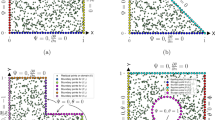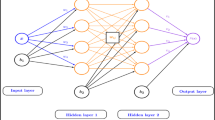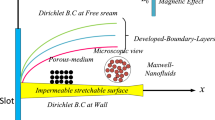Abstract
A neural solution methodology, using a feed-forward and a convolutional neural networks, is presented for general tensor elliptic pressure equation with discontinuous coefficients. The methodology is applicable for solving single-phase flow in porous medium, which is traditionally solved using numerical schemes like finite-volume methods. The neural solution to elliptic pressure equation is based on machine learning algorithms and could serve as a more effective alternative to finite volume schemes like two-point or multi-point discretization schemes (TPFA or MPFA) for faster and more accurate solution of elliptic pressure equation. Series of 1D and 2D test cases, where the results of Neural solutions are compared to numerical solutions obtained using two-point schemes with range of heterogeneities, are also presented to demonstrate general applicability and accuracy of the Neural solution method.























Similar content being viewed by others
Notes
A grid is called orthogonal if all grid lines intersect at a right angle.
References
Durlofsky LJ (1993) A triangle based mixed finite element finite volume technique for modeling two phase flow through porous media. J Comput Phys 1:252–266
Edwards MG (2002) Unstructured, control-volume distributed, full-tensor finite volume schemes with flow based grids. Comput Geo 6:433–452
Eigestad GT, Klausen RA (2005) On convergence of multi-point flux approximation o-method; numerical experiment for discontinuous permeability. (2nd edn). Submitted to Numer Meth Part Diff Eqs
Guo X, Li W, Iorio F (2016) Convolutional neural networks for steady flow approximation. https://doi.org/10.1145/2939672.2939738
Hagan MT, Demuth HB, Beale MH (1996) Neural Network Design. PWS Publishing, Boston
Li Z, Kovachki N, Azizzadenesheli K, Liu B, Bhattacharya K, Stuart A, Anandkumar A (2021) Fourier neural operator for parametric partial differential equations. https://doi.org/10.48550/arXiv.2010.08895.
Pal M, Makauskas P, Malik S (2023) Upscaling porous media using neural networks: a deep learning approach to homogenization and averaging. https://doi.org/10.3390/pr11020601
Recktenwald G (2014) The control-volume finite-difference approximation to the diffusion equation
Aavatsmark I (2002) Introduction to multipoint flux approximation for quadrilateral grids. Comput Geo No 6:405–432
Kirill Zubov et al. (2021) NeuralPDE: automating physics-informed neural networks (PINNs) with error approximations. http://arxiv.org/2107.09443arXiv:https://arxiv.org/abs/2107.09443
The Julia Programming Language. Version 1.7.3 (2022) Jeff Bezanson, Alan Edelman, Viral B. Shah and Stefan Karpinski, 2009, https://julialang.org/
Pal M, Edwards MG (2006) Effective upscaling using a family of flux-continuous, finite-volume schemes for the pressure equation. In Proceedings, ACME 06 Conference, Queens University Belfast, Northern Ireland-UK, pages 127–130
Pal M, Edwards MG, Lamb AR (2006) Convergence study of a family of flux-continuous, Finite-volume schemes for the general tensor pressure equation. Numer Method Fluids 51(9–10):1177–1203
Pal M (2007) Families of control-volume distributed cvd(mpfa) finite volume schemes for the porous medium pressure equation on structured and unstructured grids. PhD Thesis, University of Wales, Swansea-UK
Pal M, Edwards MG (2008) The competing effects of discretization and upscaling - A study using the q-family of CVD-MPFA. ECMOR 2008 - 11th European Conference on the Mathematics of Oil Recovery
Pal M (2010) The effects of control-volume distributed multi-point flux approximation (CVD-MPFA) on upscaling-A study using the CVD-MPFA schemes. Int J Numer Methods Fluids 68:1
Pal M, Edwards MG (2011) Non-linear flux-splitting schemes with imposed discrete maximum principle for elliptic equations with highly anisotropic coefficients. Int J Numer Method Fluids 66(3):299–323
Pal M (2012) A unified approach to simulation and upscaling of single-phase flow through vuggy carbonates. Intl J Numer Method Fluids. https://doi.org/10.1002/fld.2630
Pal M, Edwards MG (2012) The effects of control-volume distributed multi-point flux approximation (CVD-MPFA) on upscaling-A study using the CVD-MPFA schemes. Int J Numer Methods Fluids. https://doi.org/10.1002/fld.2492
Zhang Wenjuan, Kobaisi Al, Mohammed, (2022) On the monotonicity and positivity of physics-informed neural networks for highly anisotropic diffusion equations. MDPI Energ 15:6823
Ahmad S Abushaika (2013) Numerical methods for modelling fluid flow in highly heterogeneous and fractured reservoirs
Pal M, Lamine S, Lie K-A, Krogstad S (2015) Validation of multiscale mixed finite-element method. Int J Numer Methods Fluids 77:223
Pal M (2021) On application of machine learning method for history matching and forecasting of times series data from hydrocarbon recovery process using water flooding. Petrol Sci Technol 39:15–16
Pal M, Makauskas P, Saxena P, Patil P (2022) The neural upscaling method for single-phase flow in porous medium. Paper Presented at EAGE-ECMOR 2022 Conference
Ken Perlin (1985) An image synthesizer. SIGGRAPH. Comput Graph 19:287–296. https://doi.org/10.1145/325165.32524
Ricky TQ, Chen Yulia Rubanova, Jesse Bettencourt, David Duvenaud (2018) Neural ordinary differential equations. 32nd Conference on Neural Information Processing Systems (NeurIPS 2018), Canada
Vasilyeva M, Tyrylgin A (2018) Machine learning for accelerating effective property prediction for poroelasticity problem in stochastic media. arXiv:https://arxiv.org/abs/1810.01586
Wu J-L, XioaH Paterson EG (2018) Physics-informed machine learning approach for augmenting turbulence models: A comprehensive framework. Phys Rev Fluids 2:073602
Russel TF, Wheeler MF (1983) Finite element and finite difference methods for continuous flows in porous media. Chapter 2, in the Mathematics of Reservoir Simulation, R.E. Ewing ed. Front Appl Math SIAM pp 35–106
Raissi M, Perdikaris P, Karniadakis GE (2019) Physics-informed neural networks: a deep learning framework for solving forward and inverse problems involving nonlinear partial differential equations. J Comput Phys 378:686–707
Zhao J, Zhao W, Ma Z, Yong WA, Dong B (2022) Finding models of heat conduction via machine learning. Int J Heat Mass Transfer 185:122396
Huang S, Tao B, Li J, Yin Z (2019) On-line heat flux estimation of a nonlinear heat conduction system with complex geometry using a sequential inverse method and artificial neural network. Int J Heat Mass Transfer 143:118491
Wang Y, Zhang S, Ma Z, Yang Q (2020) Artificial neural network model development for prediction of nonlinear flow in porous media. Powder Technol 373:274–288
Abad JMN, Alizadeh R, Fattahi A, Doranehgard MH, Alhajri E, Karimi N (2020) Analysis of transport processes in a reacting flow of hybrid nanofluid around a bluff-body embedded in porous media using artificial neural network and particle swarm optimization. J Mol Liquids 313:113492
Author information
Authors and Affiliations
Corresponding author
Ethics declarations
Conflict of interest
The authors declare no conflict of interest.
Additional information
Publisher's Note
Springer Nature remains neutral with regard to jurisdictional claims in published maps and institutional affiliations.
Rights and permissions
Springer Nature or its licensor (e.g. a society or other partner) holds exclusive rights to this article under a publishing agreement with the author(s) or other rightsholder(s); author self-archiving of the accepted manuscript version of this article is solely governed by the terms of such publishing agreement and applicable law.
About this article
Cite this article
Makauskas, P., Pal, M., Kulkarni, V. et al. Comparative study of modelling flows in porous media for engineering applications using finite volume and artificial neural network methods. Engineering with Computers 39, 3773–3789 (2023). https://doi.org/10.1007/s00366-023-01814-x
Received:
Accepted:
Published:
Issue Date:
DOI: https://doi.org/10.1007/s00366-023-01814-x




